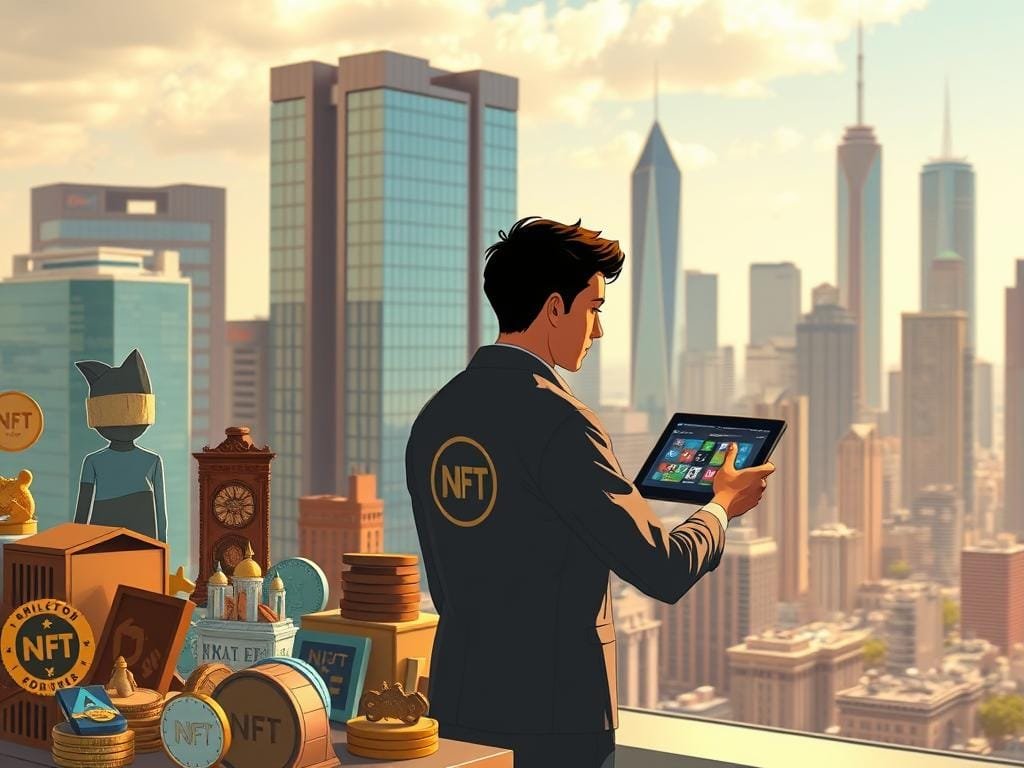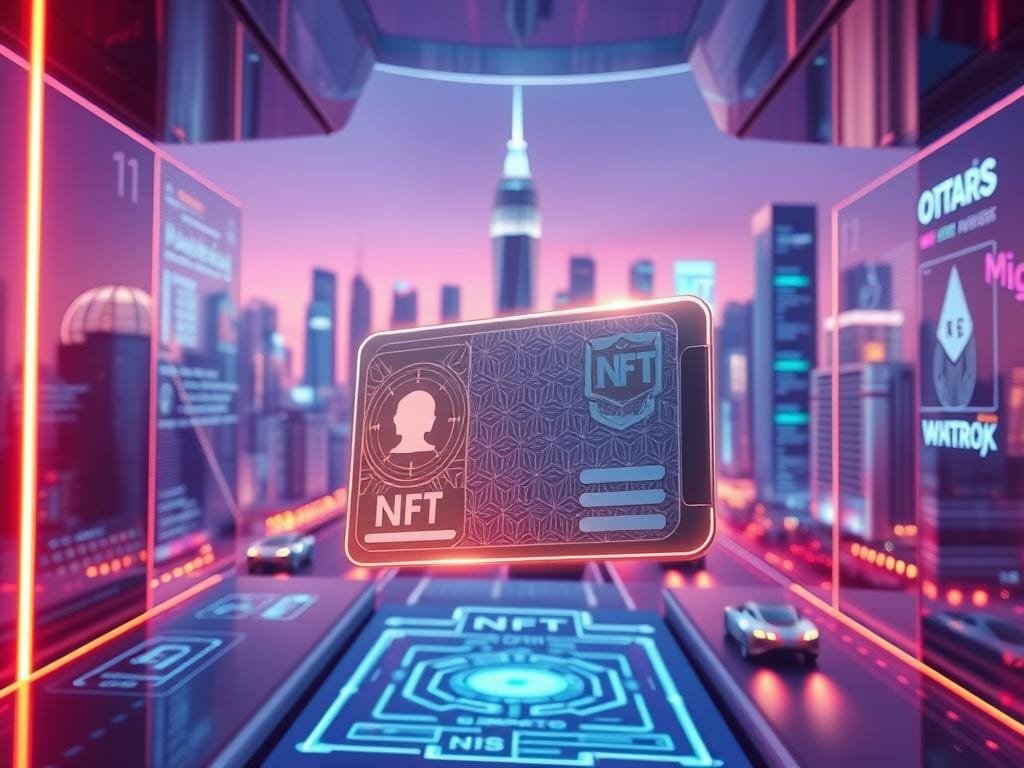The NFT market is expected to grow to over $27 billion by 2025. This shows how important non-fungible tokens are, not just for digital art. A recent article on MetaGeeks Technologies talks about how NFTs are changing many industries. These include gaming, real estate, healthcare, and supply chain management.
NFTs let players own in-game items. This means they can buy, sell, and trade items across different games and platforms. To learn more about NFTs and Web3, check out Digital Vista Online.
Key Takeaways
- NFTs are changing the gaming world by allowing true ownership of in-game assets.
- Real estate is getting easier with NFT-based platforms.
- NFTs are making medical records authentic and secure.
- Supply chain management is getting clearer with NFTs.
- NFTs are helping with self-sovereign identity and secure access.
Understanding NFTs: A Simple Introduction
As you dive into the world of digital assets, you’ll likely hear about NFTs. NFTs, or Non-Fungible Tokens, are a new way to own digital things. They’re becoming popular in many fields. To get NFTs, you need to know what they are, how they work, and some key terms.
What Are NFTs?
NFTs are unique digital tokens that show you own something special. According to Investopedia, they’re different from things like money, where one unit can be swapped for another. NFTs are special, making them perfect for digital collectibles, art, and more.

How Do NFTs Work?
NFTs use blockchain technology to keep track of who owns what. This system is safe, open, and can’t be changed. When you buy an NFT, you get a special digital item. Your ownership is recorded on the blockchain.
Key Terminology in the NFT Space
Knowing the NFT terms is key to understanding this area. Here are some important ones:
| Term | Description |
|---|---|
| NFT | Non-Fungible Token, a unique digital asset |
| Blockchain | A decentralized ledger technology used for NFT transactions |
| Digital Wallet | A software application for storing and managing digital assets |
Beyond Art: Expanding NFT Use Cases
NFTs are more than just art; they’re changing many fields like gaming, music, and sports. As NFT tech grows, new uses are popping up in these areas.
NFTs in Gaming
The gaming world is really embracing NFTs. They let gamers own special digital items that can be traded or sold. This brings in new money for both players and game makers.
NFTs can be anything from in-game items to virtual land. They’re stored on the blockchain, making sure deals are clear and safe.
“NFTs are revolutionizing the gaming industry by providing players with true ownership of digital assets.”
| Aspect | Traditional Gaming | NFT Gaming |
|---|---|---|
| Ownership | Players do not truly own in-game assets. | Players have full ownership of NFT assets. |
| Transferability | Assets are locked to a specific game. | Assets can be traded or sold across platforms. |
| Security | Transactions are controlled by the game developers. | Transactions are secured on the blockchain. |
NFTs in Music Industry
The music world is also seeing the benefits of NFTs. Artists can now sell unique digital music, like special tracks or remixes, as NFTs. This gives artists a new way to make money and connect with fans.
Also, NFTs help artists get paid fairly for their work. By tokenizing music, artists can sell directly to fans, cutting out middlemen.

For more info on NFT uses beyond art, check out this link for 14 practical examples.
NFTs in Sports
In sports, NFTs are making unique digital collectibles, like trading cards or sports moments. Fans can buy, sell, or trade these items, creating a new market for sports memorabilia.
NFTs also help sports teams connect with fans in new ways. For example, they can offer exclusive content or events.
As NFTs grow, it’s clear they’re changing more than just art. They’re changing gaming, music, and sports, too. NFTs are changing how we think about digital ownership and value.
NFTs in Real Estate: A Game-Changer
The real estate world is about to change with NFTs. They’re going to change how we own and trade properties. Let’s explore how.

Tokenizing Property Ownership
NFTs can show who owns a property. This lets you buy, sell, and trade parts of a property. It makes real estate more liquid and accessible. Tokenization creates a digital piece of ownership, safe and clear on a blockchain.
Imagine a property split into NFTs, each part owned by someone. This lets many investors share in owning a property. You can learn more about using NFTs in real estate from experts on Medium.
Streamlining Transactions
NFTs make buying and selling property easier. They automate many steps, making transfers quick and safe on a blockchain. This cuts down on the need for middlemen, saving time and money.
- Reduced transaction times
- Increased security through blockchain
- Lower costs by minimizing intermediaries
Ensuring Transparency
NFTs bring clearness to property deals. They’re recorded on a blockchain, making all transactions public. This means no one can hide the history of ownership, reducing fraud and disputes.
Transparency in real estate builds trust. It makes the market more reliable and appealing. As NFTs become more common, we’ll see a more open and efficient real estate market.
Identifying NFTs in Supply Chain Management
NFTs are changing how we manage supply chains. They use blockchain technology to make supply chains secure and clear.
Tracking Authenticity
NFTs help prove products are real. Each product gets a unique NFT. This is key for luxury items and medicines.
First, a digital copy of the product is made. This digital twin is stored on the blockchain. It’s linked to the real product, making tracking easy.
Enhancing Efficiency
NFTs make tracking and checking easier. They automate tasks, cutting down on mistakes. This saves time and effort.
They also help share info among supply chain members. This boosts teamwork and cuts down on delays.
Reducing Counterfeits
Counterfeits cost billions each year. NFTs offer a way to check if products are real.
With NFTs, companies can keep their products genuine. This protects buyers and keeps brands strong.
In summary, NFTs bring many benefits to supply chain management. They boost authenticity, efficiency, and fight counterfeits. As NFT tech grows, we’ll see more uses in this area.
NFTs for Digital Identity Verification
NFTs are becoming a key tool for digital identity verification. They offer a secure and decentralized way to manage personal data. This is vital in today’s digital world, where identity theft and data breaches are common.
Using NFTs for identity verification uses blockchain technology’s strong points. It gives individuals more control over their personal data, letting them choose who can see it and when.
Protecting Personal Data
One big advantage of NFTs for digital identity verification is better protection of personal data. NFTs help create a secure digital identity that’s hard to tamper with or access without permission.
For example, sensitive info like passport details or driver’s license numbers can be encrypted and stored on a blockchain. This keeps it safe and only lets authorized people see it.
| Benefits | Description |
|---|---|
| Enhanced Security | NFTs offer a secure way to store and manage personal data, lowering the risk of identity theft. |
| Increased Control | People have more control over their digital identity, deciding who can see their info. |
| Transparency | Blockchain technology makes all digital identity transactions clear and tamper-proof. |
Secure Credentialing
NFTs are also great for secure credentialing. They provide a reliable way to verify academic credentials, professional certifications, and more.
By issuing credentials as NFTs, schools and professional bodies can make sure these credentials are real. They can also be easily checked by employers or others who need to verify them.
Applications in Social Media
NFTs are also interesting in social media. They can help verify the identity of users on social media platforms. This reduces fake accounts and makes these platforms more secure.

In conclusion, NFTs are a promising solution for digital identity verification. They provide a secure, decentralized, and transparent way to manage personal data and credentials. As NFT technology grows, we’ll see more use in areas like social media, education, and professional certification.
The Financial Sector and NFTs
NFTs and financial services are coming together in exciting ways. This shows that NFTs are more than just a new use of blockchain. They are set to change traditional finance in big ways.
Decentralized Finance (DeFi)
Decentralized Finance, or DeFi, is all about making finance more open and accessible. NFTs are key in DeFi, providing a safe and clear way to show asset ownership. This opens up new financial tools and services, like NFT-based lending platforms.
NFTs in DeFi help create decentralized lending systems where NFTs act as collateral. This makes DeFi more varied and strong.
NFTs as Investment Vehicles
NFTs are seen as good investment options. They let investors add digital assets with real value and rarity to their portfolios.
- NFTs offer a new investment class, different from stocks and bonds.
- Their value can grow, making them a promising investment.
- NFT marketplaces are growing, where you can buy, sell, and trade NFTs.
Revolutionizing Asset Ownership
NFTs are changing how we own assets. They make owning and transferring assets secure, clear, and efficient. This affects many types of assets, from art to real estate.
| Aspect | Traditional Ownership | NFT-Based Ownership |
|---|---|---|
| Security | Physical documents or centralized records | Blockchain-based, immutable records |
| Transparency | Limited, often opaque | Publicly accessible, transparent |
| Efficiency | Often slow and cumbersome | Fast, with automated processes |
As the financial world adopts NFTs, we’ll see big changes in asset ownership and transfer. NFTs have huge potentials in DeFi, investments, and ownership. Understanding these changes is key for those in finance.
NFTs in Education: Transforming Learning Credentialing
NFTs are changing the way we issue digital diplomas and verify academic achievements. This new method makes credentialing more secure and efficient. It’s a big step forward in education.
Digital Diplomas
Digital diplomas are becoming more common thanks to NFTs. NFTs ensure that academic credentials are secure and authentic. This reduces fraud and makes diploma verification easier.
Institutions can create NFTs for academic achievements. These can be stored in digital wallets. It simplifies diploma issuance and keeps a lifelong record of achievements.
Verifying Academic Achievements
NFTs help verify academic achievements like certificates and badges. They make these achievements tamper-proof and easy to verify.
This is great for online learning, where verifying achievements can be tough. NFTs offer a reliable way to show off skills and achievements securely.
Lifelong Learning
NFTs support lifelong learning by securely recording and verifying achievements. This is very helpful for professionals who need to prove their skills to employers.
For more on NFTs in education, check out the article on Medium. It talks about how NFTs can change learning materials and credentials.
Environmental Sustainability and NFTs
NFTs are being looked at for their role in helping the environment. You might wonder how digital assets can help. They can support green projects, help with carbon credits, and spread the word about environmental problems.
Carbon Credits and NFTs
NFTs are being used in a new way with carbon credits. They make it simpler to trade these credits on an NFT platform. This makes things more transparent and encourages companies to fund green projects.
Here are some ways NFTs are being used for carbon credits:
- Tokenization of carbon credits for easier trading
- Verification of carbon credit authenticity
- Creation of a marketplace for carbon credits
Supporting Eco-Friendly Projects
NFTs can also help fund eco-friendly projects. Artists and creators can make NFTs to show their support. A part of the money made goes to these projects.
Some examples include:
- NFT art sales with proceeds going to environmental charities
- Virtual events and experiences that raise awareness and funds
- Exclusive content or access for supporters of eco-friendly projects
Awareness Campaigns
NFTs are also great for raising awareness. They can create unique digital assets that focus on environmental issues. This way, creators can bring attention to important causes.
Key strategies for NFT awareness campaigns include:
- Collaborating with influencers and environmental organizations
- Creating engaging and informative content
- Utilizing social media platforms to amplify the message
Exploring NFTs for environmental sustainability opens up many opportunities. They can help with carbon credits, support green projects, and raise awareness. NFTs are set to play a big role in making our future more sustainable.
The Future of NFTs: Trends to Watch
NFTs are growing fast, with new tech, more uses, and clear rules coming. They will change many fields, like art, entertainment, real estate, and finance.
Advancements in NFT Technology
New tech will shape NFTs’ future. Better scalability, security, and ease of use will open more doors. This will help NFT auctions grow, benefiting creators and collectors.
Growing Adoption and Regulatory Considerations
NFTs will be used in new ways, like digital IDs and supply chain tracking. As the market expands, rules will be set to guide NFT use.
Keeping up with these trends helps you stay ahead in the NFT world. You can find new chances to succeed.
FAQ
What is the main difference between NFTs and traditional digital assets?
NFTs, or non-fungible tokens, are unique digital assets. They can’t be swapped for another identical one. Traditional digital assets, on the other hand, are often fungible. This means they can be exchanged for another identical asset.
How do NFTs utilize blockchain technology?
NFTs use blockchain technology. This technology records ownership and provenance. It ensures the asset’s scarcity and authenticity.
What are some of the key benefits of using NFTs in supply chain management?
NFTs help track authenticity and improve efficiency. They reduce counterfeits by providing a secure record of ownership and movement.
Can NFTs be used for digital identity verification?
Yes, NFTs can protect personal data. They enable secure credentialing. They also have applications in social media, making them a solution for digital identity verification.
How are NFTs being used in the financial sector?
NFTs are explored for DeFi and as investment vehicles. They could revolutionize asset ownership. This could disrupt traditional financial systems.
What role can NFTs play in environmental sustainability?
NFTs can be used for carbon credits. They support eco-friendly projects and raise awareness about environmental issues. They contribute to a more sustainable future.
How might NFTs change the way we approach education and credentialing?
NFTs can issue digital diplomas and verify academic achievements. They support lifelong learning. This could transform education and credentialing.
What are some of the challenges associated with NFT adoption?
Challenges include regulatory considerations and evolving technology. There’s also the environmental impact of NFTs.
What is the future outlook for NFTs and their applications?
The future of NFTs looks promising. They will see increased adoption across sectors. Technology will advance, and regulations will evolve. This could lead to widespread transformation across industries.
